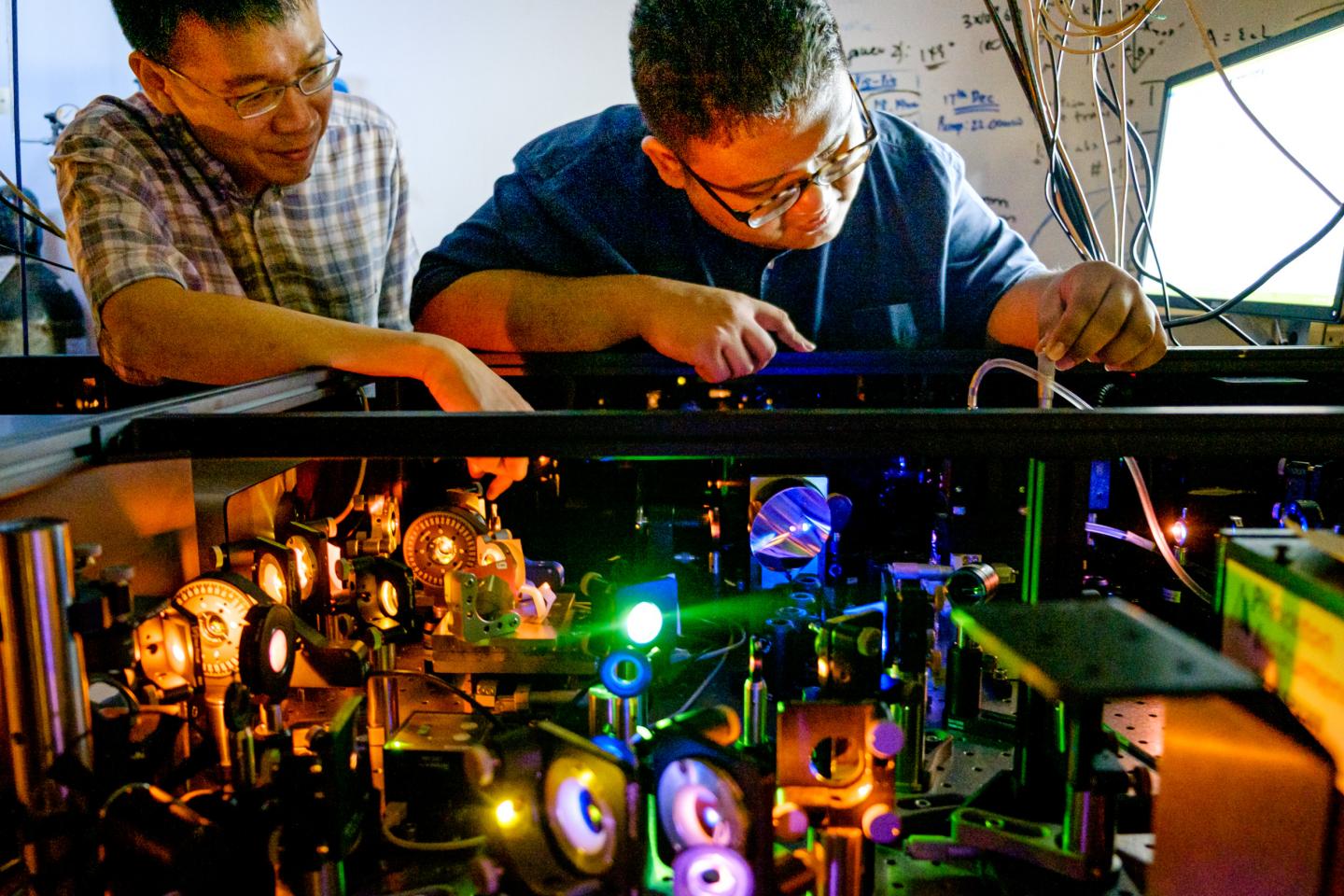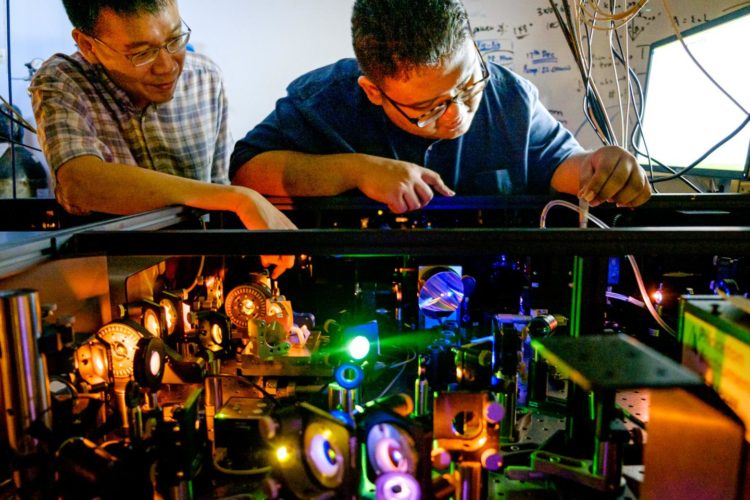
Credit: NTU Singapore
An international research team jointly led by Nanyang Technological University, Singapore (NTU Singapore), the U.S. Department of Energy’s (DOE) Argonne National Laboratory and Germany’s Deutsches Elektronen-Synchrotron (DESY) has for the first time observed the ultrafast formation and then breakdown of the water ion that is created when water is exposed to ionising radiation.
The water ion plays a crucial role in many chemical reactions, but has never been directly observed due to its extremely short lifetime.
When ionising radiation with enough energy hits water molecules (H2O), it forcefully strips an electron away from them, creating the water ion known as a radical cation (H2O+), which is missing an electron and is therefore highly unstable.
The H2O+ radical then gives up a proton to a neighbouring water molecule, creating both hydronium (H3O+) and a hydroxyl radical (OH), in a step known as ‘proton transfer’. All of this occurs in just 50 femtoseconds (50 quadrillionths of a second, or 0.000 000 000 000 05 of a second.)
Scientists believe that the H2O+ radical is the first chemical species in a long cascade of chain reactions that can eventually lead to radiation damage in biological tissue. Highly reactive radicals, such as the OH radical, have been reported by other studies to strip electrons from stable compounds that are rich in electrons, such as DNA.
This eventually leads to a cascade reaction where DNA strands become damaged and fall apart. Most of the time the cell’s machinery corrects this damage, but if it does not it can lead to the first steps in changes to the DNA which become mutations and may eventually cause serious problems, including cancer.
The proton transfer reaction is significant in a wide range of fields, including nuclear engineering, space travel and environmental remediation. It also helps scientists better understand how radiation interacts with water in aqueous environments, such as in biological systems and water-cooled nuclear reactors.
Published today in Science, the clocking of this chemical reaction in ionised water was the result of an international collaboration between NTU Singapore, Argonne National Laboratory and the German research centre DESY, with the experiments conducted at SLAC National Accelerator Laboratory, USA. The study also included contributions from other institutions in the US and Germany, including those from Sweden, France and Denmark.
The publication marks the latest discovery by lead author, NTU Associate Professor Loh Zhi-Heng, whose group has studied the ultrafast dynamics of ionising molecules using ultrafast lasers for the past nine years. His team included PhD student Mr Muhammad Shafiq Bin Mohd Yusof and Dr Tushar Debnath, a former postdoctoral researcher who is currently a Humboldt Research Fellow at LMU Munich.
The chemical reactions involving the water ion are among the fastest known to mankind and to capture its existence the team used a state-of-the-art X-ray free-electron laser.
“While we had observed a glimpse of the possible lifetime of the H2O+ radical in earlier experiments using femtosecond lasers at NTU, its direct spectroscopic observation lies beyond the capability of most tabletop equipment,” said Assoc Prof Loh, who is also the Assistant Chair (Academic) at NTU’s School of Physical and Mathematical Sciences.
“However, using the ultrafast x-ray laser at SLAC enabled us to not only observe the proton transfer, but will also potentially allow us to precisely determine what happens before, during and after the reaction.”
“What we are observing is like the prequel to radiation damage – the very first chemical reaction which leads to subsequent chemical reactions that lead to what scientists have classified as radiation damage. If we can fully understand how this chemical reaction happens, then finding a way to stop or reverse this reaction could pave the way towards stopping or reducing radiation damage in biological cells.”
Scientists have long studied the ionisation of water, with a first sighting in the 1960s by scientists at Argonne of the hydrated electron that is produced by the radiolysis of water. However, without a sufficiently fast X-ray probe like that provided by the Linac Coherent Light Source (LCLS) at SLAC, a DOE Office of Science User Facility, researchers had no way to observe the residual positively charged ion, the other half of the reaction pair.
“The truly exciting thing is that we’ve witnessed the fastest chemical reaction in ionised water, which leads to the birth of the hydroxyl radical,” said Argonne Distinguished Fellow and Professor of Physics at The University of Chicago, Prof Linda Young, the senior corresponding author of the study.
“The hydroxyl radical is itself of considerable importance, as it can diffuse through an organism, including our bodies, and damage virtually any macromolecule including DNA, RNA, and proteins.”
By understanding the time scale for the formation of the chemically aggressive hydroxyl radical and, thereby, gaining a deeper mechanistic understanding of the radiolysis of water, it may become possible to develop strategies to suppress this key step that can lead to radiation damage.
The development of the theory behind the experiment was led by Prof Robin Santra of the Center for Free-Electron Laser Science at DESY in Germany. Santra showed that using the technique of ultrafast X-ray absorption, scientists could detect the structural dynamics–both in terms of electron and nuclear motion–near the ionization and proton transfer site.
“We could show that the X-ray data actually contain information on the dynamics of the water molecules that enable the proton transfer,” said Santra, who is a lead scientist at DESY and principal investigator at the Hamburg Centre for Ultrafast Imaging, a cluster of excellence at the University of Hamburg and DESY.
“In just 50 quadrillionths of a second, the surrounding water molecules literally move in on the ionized H2O+ until one of them comes close enough to grab one of its protons in a sort of handshake, turning into hydronium H3O+ and leaving behind the hydroxyl radical OH.”
Understanding the formation of the hydroxyl radical could be of interest in aqueous environments containing salts or other minerals that might in turn react with ionised water or its byproducts. Such environments could include nuclear waste repositories or other places in need of environmental remediation.
###
Notes to Editor:
Paper titled “Observation of the fastest chemical processes in the radiolysis of water”, published in Science, 9 Jan 2020, 2pm U.S. Eastern Standard Time.
Media contact:
Lester Kok
Assistant Director
Corporate Communications Office
Nanyang Technological University, Singapore
Email: [email protected]
About Nanyang Technological University, Singapore
A research-intensive public university, Nanyang Technological University, Singapore (NTU Singapore) has 33,000 undergraduate and postgraduate students in the Engineering, Business, Science, Humanities, Arts, & Social Sciences, and Graduate colleges. It also has a medical school, the Lee Kong Chian School of Medicine, set up jointly with Imperial College London.
NTU is also home to world-class autonomous institutes – the National Institute of Education, S Rajaratnam School of International Studies, Earth Observatory of Singapore, and Singapore Centre for Environmental Life Sciences Engineering – and various leading research centres such as the Nanyang Environment & Water Research Institute (NEWRI) and Energy Research Institute @ NTU (ERI@N).
Ranked 11th in the world, NTU has been placed the world’s top young university for the past six years. The NTU Smart Campus is frequently listed among the Top 15 most beautiful university campuses in the world and it has 57 Green Mark-certified (equivalent to LEED-certified) building projects, of which 95% are certified Green Mark Platinum. Apart from its main campus, NTU also has a campus in Novena, Singapore’s healthcare district.
For more information, visit http://www.
Media Contact
Lester Kok
[email protected]
65-679-06804





